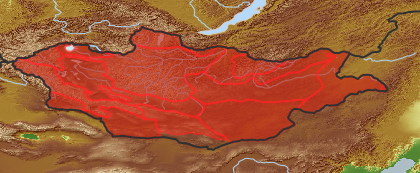| Class: | angiosperms |
| Order: | Malpighiales |
| Family: | Salicaceae |
| Genus: | Salix |
| Herbar: | list records    |
| Description: | 1 or 2 oblong nectaries at base of ovary and stamens. Buds lateral with usually 1 scale. Catkins strict upwards, floral scales with entire margins. |
| Comments: | See also: http://www.manfred-vesper.de/datei.php?did=214 [DE] and http://www.manfred-vesper.de/datei.php?did=273 [MON] |
| Link to Flora of China: | http://www.efloras.org/florataxon.aspx?flora_id=2&taxon_id=129059 |
| open map in a new window |  |
| species: 44 |
| Habit (i)general appearance of a plant | |
| Growth form: (i)Herb, shrub, tree or climber. | herb (i)Herbaceous, erect plant, up to 2m high, mostly with a leafy shoot; if perennial, shoots die to the ground each season, shoots are not woody
example: Artemisia pectinata   inherited by family Salicaceae: herb inherited by family Salicaceae: herb
perennial (i)Living for several to many years, as opposed to annual and biennial  inherited by family Salicaceae: perennial inherited by family Salicaceae: perennial
shrub, subshrub or semishrub (i)Shrub, multi-stemmed, mostly (0.2) 0.5 - 5 m high, shoots woody up to the tip
example: Caragana leucophloea   inherited by family Salicaceae: shrub, subshrub or semishrub inherited by family Salicaceae: shrub, subshrub or semishrub
tree (i)Woody plant with a clear main trunk, at least 2-3 m tall
example: Ulmus pumila   inherited by family Salicaceae: tree inherited by family Salicaceae: tree
|
| Parasite status: (i)Is the plant a half- or full parasite? | no parasite/saprophyte (i)Plant fully autonomous, leaves with chlorophyll
example: Most plants, Ranunculus  inherited by family Salicaceae: no parasite/saprophyte inherited by family Salicaceae: no parasite/saprophyte
|
| Water or terrestrial plant: (i)Where do the plants grow? | terrestrial (i)Plant grows on dry land
example: Orostachys spinosa  inherited by family Salicaceae: terrestrial inherited by family Salicaceae: terrestrial
|
| Leaf (i)expanded, usually photosynthetic organ of a plant (including phylloclades) | |
| Leaf development: (i)Structure and development of leaves. | with green leaves (i)Plant with green leaves  inherited by family Salicaceae: with green leaves inherited by family Salicaceae: with green leaves
|
| Leaf arrangement: (i)Arrangement of leaves at the stem. | alternate (i)One leaf per node; distiche: arranged in two vertical rows, equitant
example: Phragmites    inherited by family Salicaceae: alternate inherited by family Salicaceae: alternate
|
| Simple or divided leaves: (i)Are the leaves simple or completely divided in several parts? Blade of the leaf entire or (more or less) deeply dissected. Attention: There are various appearances of the leaf margin (from entire to toothed and lobed). Here, we ignore this and ask only for dissections that separate the leaf for more than one third of its length or width, whatever is smaller. Sometimes, it is difficult to tell apart compound leaves from a shoot system with simple leaves: look for stipulae and/or axillary buds at the ground of the leaves: if only some possess these structures, the others are most likely leaflets of a compound leaf. | simple (i)Non-divided leaf, but margin may be incised nearly to the ground   inherited by family Salicaceae: simple inherited by family Salicaceae: simple
|
| Petiole: (i)Leaf divided into stalk (petiole) and blade. | with (i)Leaves with petiole (stalk)   inherited by family Salicaceae: with inherited by family Salicaceae: with
|
| Stipule: (i)Leaflets at the base of the petiole, these are smaller and of different shape. | none (i)Without stipules
example: Euphorbia, Ericaceae s.l.  inherited by family Salicaceae: none inherited by family Salicaceae: none
pair (i)A pair of free stipulae
example: Lathyrus, Trifolium   inherited by family Salicaceae: pair inherited by family Salicaceae: pair
|
| Leaf veination: (i)Arrangement of the main veins of a leaf. | pinnate (i)One main vein, several side veins, sometimes inconspicuous
example: Cicerbita     inherited by family Salicaceae: pinnate inherited by family Salicaceae: pinnate
|
| Flower (i)reproductive portion of the plant, consisting of sepals, petals, stamens, and pistils | |
| Flower appearance and pollination: (i)General appearance of the flower. | not attractive, wind-pollinated or some water plants (i)Small, colourless or green flowers
example: Betula, grasslike plants: Carex, Setaria, Juncus  inherited by family Salicaceae: not attractive, wind-pollinated or some water plants inherited by family Salicaceae: not attractive, wind-pollinated or some water plants
|
| Perianth arrangement: (i)Attention: in some plants, flowers may be dimorphic in different ways (dioecious or gynodioecious). If flowers vary, record the characters of the most showy flowers. | absent or strongly reduced (i)No perianth leaves ensheathing stamen and/or carpels
example: Callitriche   inherited by family Salicaceae: absent or strongly reduced inherited by family Salicaceae: absent or strongly reduced
|
| Diameter of flower: (i)Diameter of flower or flower head. | to 5 mm (i)
example: Aruncus  inherited by family Salicaceae: inherited by family Salicaceae:
from 5 mm to 10 mm (i)
example: Stellaria  inherited by family Salicaceae: inherited by family Salicaceae:
|
| Spur: (i)A hollow, slender, sac-like appendage of the perianth leaves, storing nectar. | no spur (i)Flower without appendage
example: Peganum  inherited by family Salicaceae: no spur inherited by family Salicaceae: no spur
|
| Stamen number: (i)Attention: We ask for the reproductive organs of the flower dispersing pollen. Count only fully fertile stamens, not staminodia (e.g. Parnassia). | 2 (i)
example: Cypripedium
3 (i)
example: Poa, Iris
5 (i)
example: Peucedanum
|
| Stamen fusion: (i)To which degree are the stamens fused? Attention: Whereas the pollen sacs itself are often free., their stalks (filaments) may be fused. Here, we count them as fused if they are together over at least one thirth of their length. | free (i)Stamens with separate bases
example: Malus  inherited by family Salicaceae: free inherited by family Salicaceae: free
fused with each other (i)All or most stamens fused with each other to a tube-like structure
example: Caragana, Petasites
|
| Pistil number: (i)Number of pistils (female floral organs: style, if developed; stigma and carpels/ovary together build the pistil). | 1 (i)One carpel, but clearly one stigma
example: Pyrola, Primula, Alyssum  inherited by family Salicaceae: 1 inherited by family Salicaceae: 1
|
| Carpel fusion: (i)To which degree are the carpels (modified leaf forming simple pistil or part of a compound pistil) fused. | fused (i)Carpels united into an ovary, only styles are free
example: Malus, Berberis  inherited by family Salicaceae: fused inherited by family Salicaceae: fused
|
| Stigma number per style: (i)Number of stigmas per style. | 2 (i)Two stigmas, resulting from two fused carpels with or without developed style   inherited by family Salicaceae: 2 inherited by family Salicaceae: 2
|
| Ovary position: (i)For entirely or partly fused carpels, describe their position in relation to the insertion point of perianth leaves (best done by doing a longitudinal section of a flower). | superior (hypogynous) (i)Base of carpels attached above insertion point of perianth leaves, carpels free or fused
example: Delphinium, Anemone    inherited by family Salicaceae: superior (hypogynous) inherited by family Salicaceae: superior (hypogynous)
|
| Sex: (i)Distribution of male and female organs among flowers, only most commonly cases. | unisexual (i)
example: Rhodiola  inherited by family Salicaceae: unisexual inherited by family Salicaceae: unisexual
dioecious (i)Male and female flowers at different individuals
example: Antennaria  inherited by family Salicaceae: dioecious inherited by family Salicaceae: dioecious
|
| Inflorescence (i)flowering part of a plant, describes the arrangement of the flowers on the flowering axis | |
| Inflorescence: (i)Structure of the inflorescence. | Flowers in inflorescence (i)No solitary flowers  inherited by family Salicaceae: Flowers in inflorescence inherited by family Salicaceae: Flowers in inflorescence
Compound inflorescences (i)Flowers on shoots of higher orders (complex branched)
example: Solidago   inherited by family Salicaceae: Compound inflorescences inherited by family Salicaceae: Compound inflorescences
|
| Appearance: (i)Outer look of the inflorescence. | axillary (i)Usually several inflorescences in axillary shoots or single flowers in leaf axils, main shoot remains mostly leafy
example: Tragopogon, Aconogonon  inherited by family Salicaceae: axillary inherited by family Salicaceae: axillary
|
| Inflorescence type: (i)Types of inflorescence. Attention: We here ask for the botanical nomenclature of inflorescences, which is sufficiently complicated. Tick only, if you are certain, or tick all inflorescence types that appear similar of these of the plant in question. | catkin (i)Mostly unisexual flowers, in pendulous spikes ore racemes, often falling as a whole after fruiting
example: Betula (male pendulous, female upward), Corylus (only male inflorescences, pendulous), Salix (strict upward), Populus (pendulous)   inherited by family Salicaceae: catkin inherited by family Salicaceae: catkin
others (in traits_comments nicht aufgeführt) (i)Not as above
example: Sparganium: globose capitate  inherited by family Salicaceae: others (in traits_comments nicht aufgeführt) inherited by family Salicaceae: others (in traits_comments nicht aufgeführt)
|
| Fruit (i)the seed bearing organ, with or without adnate parts; a ripened ovary and any other structures which are attached and ripen with it. Aggregate fruits are handled like simple fruits for determination. | |
| Consistency: (i)Fleshy fruits or dry fruits, see dispersal adaptations for further classification. | dry (i)With a dry outer shell, no fleshy parts, but seed (embryo) could be edible  inherited by family Salicaceae: dry inherited by family Salicaceae: dry
|
| Type of fruit: (i)Common fruit types (including pseudocarp). | Solitary fruits (i)     inherited by family Salicaceae: Solitary fruits inherited by family Salicaceae: Solitary fruits
capsule (i)Dry dehiscent fruit, releasing seeds by slits or holes.
example: Poppy, most Caryophyllaceae, Cerastium, a lot of Scrophulariaceae, Iris (oppened capsule looks like Delphinium), Zygophyllum - it is a very common fruit type     inherited by family Salicaceae: capsule inherited by family Salicaceae: capsule
Dehiscent fruits (i)Fruits open along a longitudinale line (except silicula)  inherited by family Salicaceae: Dehiscent fruits inherited by family Salicaceae: Dehiscent fruits
|
| Opening of fruit: (i)Mode of dehiscence at maturity to release seeds. | not opening / indehiscent (i)Fruits remain closed at maturity and disperse with seeds inside
example: Corylus (nut), Vaccinium (berry)  inherited by family Salicaceae: not opening / indehiscent inherited by family Salicaceae: not opening / indehiscent
|
| Size of fruit: (i)Size of the fruit including appendage. | to 5 mm (i)
example: Halerpestes: many folicles forming dry nutlets  inherited by family Salicaceae: inherited by family Salicaceae:
|
| Dispersal: (i)Appearance of fruit or seed (if single) and adaptations to dispersal. | Flying (wind dispersed) (i)Fruits or seeds with appendages to fly
example: Taraxacum, Atraphaxis, Pulsatilla  inherited by family Salicaceae: Flying (wind dispersed) inherited by family Salicaceae: Flying (wind dispersed)
|
| Root / shoot below ground (i)plant part below ground (in most cases), including below ground shoots, without leaves | |
| Root type: (i)Organisation of the roots. | allorhizous (i)Plant with a conspicuous tap root, one larger tap root with side roots
example: Dicotyledonae  inherited by order Malpighiales: allorhizous inherited by order Malpighiales: allorhizous
|